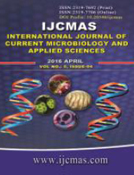


 National Academy of Agricultural Sciences (NAAS)
National Academy of Agricultural Sciences (NAAS)

|
PRINT ISSN : 2319-7692
Online ISSN : 2319-7706 Issues : 12 per year Publisher : Excellent Publishers Email : editorijcmas@gmail.com / submit@ijcmas.com Editor-in-chief: Dr.M.Prakash Index Copernicus ICV 2018: 95.39 NAAS RATING 2020: 5.38 |
Developing new bioremediation processes for soils and effluents polluted by heavy metals is one the serious concern. For the same, extensive screening for the fungal resistance to heavy metals such as lead, nickel, cobalt, chromium, copper, manganese and zinc was attempted. During this SG1 isolate was obtained having maximum threshold level of tolerance to manganese (60 mg/ml), copper (5 mg/ml), cobalt (5 mg/ml), lead (4.5 mg/ml), nickel (6 mg/ml), chromium (3.9 mg/ml) and GK1 isolate was obtained having maximum threshold level of tolerance to zinc (80 mg/ml). Maximum growth of the isolate SG1 at threshold concentrations of metals was found to be at pH 5 and temperature 30oC in presence of manganese, pH 5 and 32oC with copper, pH 5 and 30oC with cobalt, pH 5 and 31oC with lead, pH 5 and 30oC with nickel, pH 5 and 29oC with chromium while isolate GK1 showed at pH 4 and 30oC with zinc. Besides metal tolerance further antibiotic resistance pattern of these isolates were also studied. The results revealed that antibiotic resistance and metal resistance were highly coupled. GK1 was found to have multiple antibiotic resistances. UV mutagenesis has been found to be productive in terms of the increase in resistance against the metal ions. A mutant of GK1 was found to show improved resistance against Zn up to 82 mg/ml. Based on the morphological characterization, it was found that the isolates SG1 and GK1 were of Neurospora sp. and Penicillium sp. respectively.
 |
 |
 |
 |
 |